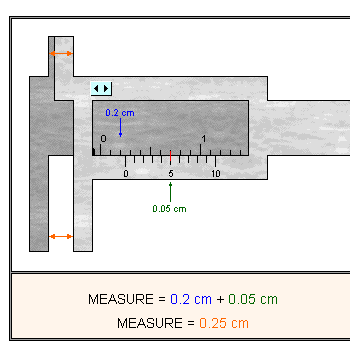Lesson 2: Using Measuring Instruments
Explore

trundle wheel: © Bart Coenders/iStockphoto; Vernier caliper: © Adem Demir/shutterstock
Glossary Terms
In this course you will often come across math-related words that may be unfamiliar to you. In Lesson 1 you started a list of glossary terms.
Add the following terms to your “Glossary Terms” page:
-
circumference
-
diameter
-
dimensions
-
irregular shape
-
trundle wheel
-
vernier caliper
------------------------------------------------------------------------------
You have the SI (metric) units and the imperial units estimated as body referents, your ruler, an online caliper, and a tape measure, so where do you start? Well, it depends on what you are trying to measure and how accurate a measurement you require.
In construction, sometimes you need a sledge hammer and sometimes you need a ball-peen hammer. The same idea applies in measurement: different instruments provide different scales. You will investigate measurement instruments and their usefulness.
![]() Watch and Listen
Watch and Listen
Trundle Wheel
Have you ever had to measure a distance that is too long for a tape measure or a metre-stick? Maybe you want to know how far it is to the end of your street. Instead of using a stretched-out tape measure over and over, you can use a trundle wheel.
The video titled “Trundle Wheel” will show you how.
-----------------------------------------------------------------------------------------------------
Vernier Caliper
A plumber may have to measure the diameter of a PVC (polyvinyl chloride) pipe in order to know if the pipe will be suitable for a repair job. One way to obtain the proper measurement is by using a vernier caliper. A Vernier Caliper allows for very precise measurements for items that are difficult to measure using other tools (circular items, very small items).
Generally, to read a Vernier Caliper, we use the top scale ( the main scale) for the first decimal and the bottom scale for the second decimals. Here are some steps for using a vernier caliper:
1. For the tenths digit, look to see where the 0 on the bottom scale is located in reference to the top scale. Choose the number that is just before where the 0 is located.
2. Now look to the bottom scale and see where the lines match up perfectly for the first time. This gives the hundredth digit.
Here are a few solved examples for you to look through.


----------------------------------------------------------------------------------------
SI Ruler
Click below to watch how to measure using an SI ( Metric) ruler.
----------------------------------------------------------------------------------------
Imperial Ruler
Use the link below to watch how to use an Imperial Ruler for measuring.
------------------------------------------------------------------------
![]() Try This
Try This
Complete the following in your course folder (binder).
TT 7. Using the provided imperial ruler, how long does the red line measure?

TT 8. Use a piece of string and a ruler or a tape measure to measure the circumference of a round or cylindrical object. Some objects you may consider measuring include a glass, a basketball, a can of soup, or an orange. Is this technique an effective way to measure the circumference of objects that you found? Explain.
TT 9. If you have access to a trundle wheel, use the wheel to measure the perimeter of a room in your immediate environment. Is there a better way to measure the perimeter of a room? Explain.
Use the link below to check your answers to Try This 7 - 9.
Whenever you have been required to measure something in this lesson, you have also been told which measurement instrument to use. However, as you work on projects in your home, you will need to decide for yourself what are the most appropriate instruments and units to use.
When deciding which measurement instrument to use, you will need to consider the following.
|
Question |
Considerations |
|
What measurement instruments do I have available? |
You may have limited options. You may have to borrow or purchase the right instrument. |
|
Am I measuring something that is short or long? |
You likely won’t want to measure the length of a hallway with a ruler or the thickness of a dime with a trundle wheel. |
|
Is the scale on the measurement instrument big enough? |
You can’t measure the diameter of a beach ball using a vernier caliper! |
|
Are the divisions on the scale small enough to give a precise measurement? |
How precise you want the measurement to be may determine which instrument you need to use. |
You will also need to decide what unit of measurement to use when measuring an object. Some questions you will need to answer include these ones.
|
Question |
Considerations |
|
Do I need the measurement to be in SI units or imperial units? |
You may need to report measurements in SI units if previous measurements were also in SI units. |
|
Am I measuring something that is short or long? |
If something is long, like the length of a building, you would likely avoid using inches or millimetres as the units of measure. |
|
What measurement instrument am I using? |
The instrument that you use will have a certain scale; |
|
Which units will give me a reasonable answer? |
The length of a swimming pool could be reported as 50 000 mm, 5000 cm, 50 m, or 0.05 km. The most appropriate example is 50 m. |
![]() Self-Check
Self-Check
SC 1. Match the following scenarios with the correct measurement instruments.
|
|
|
|
|
|
|
|
SC 2. You have used your caliper to determine that a Canadian dime has a thickness of 1.22 mm and a diameter of 18.03 mm.
- Determine the circumference of this dime.
- How many dimes can fit into a container that has the following dimensions?




 inch or cm or m.
inch or cm or m.